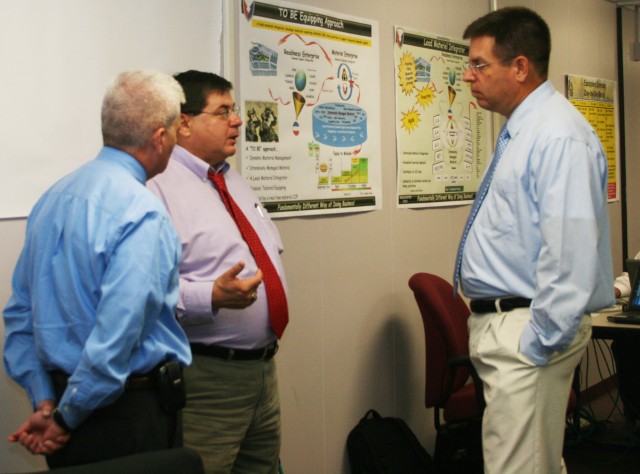Army Sustainment Command headquarters hosted a rehearsal of concept drill July 26-30, testing a new equipping strategy.
Senior leaders from Army Materiel Command and the Office of the Assistant Secretary of the Army for Acquisition, Logistics and Technology joined their ASC hosts for an Army Force Generation "Equipping" conference.
AMC is leading the Equipping Task Force, at the request of the Chief of Staff of the Army, to gain a clearer understanding of how the Army equips forces today, uncover flaws in how it's currently done and propose solutions.
As part of its study, AMC is producing a cost-benefit analysis, comparing the Army's current equipping process to a new "to-be" approach. Analyzing the proposed changes will provide key decision makers with an estimate for the cost and benefits associated with a new way of doing business.
The Army's current equipping strategy lacks a set of fundamental processes and decision support tools, according to drill organizers. The new to-be approach will be supported by one integrating data repository, unlike the current system, which is supported by multiple equipment databases spanning the Army's organizational structure - with no integrated source of accurate materiel data. The "Logistics Information Warehouse," operated by AMC's Logistics Support Activity, is the proposed solution for a common database.
"The Army has to transform and change the way it equips in support of ARFORGEN because under the old processes of equipping and readiness, only 84 percent of equipment is on-hand for Army requirements. This means the Army's materiel requirements exceed the on-hand supply. With ARFORGEN we are going to a cyclic readiness approach and we will have to have a different and progressive approach to materiel readiness," said Col. Ed Agee, director of materiel management, AMC Headquarters.
The drill compared alternative actions for distribution integration, data integration, process automation and business rules. Each area was examined to provide decision makers with a cost estimate and benefit associated with each element of change.
Maj. Gen. Yves J. Fontaine, ASC commanding general, said the entire process must leverage automation.
"The goal is to gain visibility of all of the equipment within the Army and place that information within one computer [system]. This computer will then receive demand signals from requesting agencies. Once it receives the demand signal, it can compare it to available equipment and provide a solution. The end result is providing an 'Equipping' order and moving equipment to fit the requirement," Fontaine said.
Lt. Gen. Jim Pillsbury, AMC deputy commander, said the centerpiece for this equipping to-be is going to be here at the Rock Island Arsenal.
"ASC is going to be the key, as we are now talking about ASC being the materiel manager for the Army," he said.
Agee said ASC would be responsible for developing synchronized materiel sourcing solutions to meet materiel demand signals as units in the Army transition through the three phases of ARFORGEN.
Integrating automation is the biggest change with the new equipping approach, said Fontaine. A centralized system will now be possible under one materiel manager, which will have complete visibility of all Army equipment. With this switch, more effective direction of changes and equipment retrieval, based on operations and requirements in the field, will be possible.
"We are trying to transform the Materiel Enterprise to be more efficient and effective, timelier, and more proactive," Agee said.
ASC is organizing itself under a to-be approach to influence equipment readiness, in terms of equipment on-hand and serviceability.
"The roles, functions, missions and authorities will transform somewhat, but the core functions that this command will remain the same. It will transform itself to be more efficient, more effective and more proactive," said Fontaine.




Social Sharing